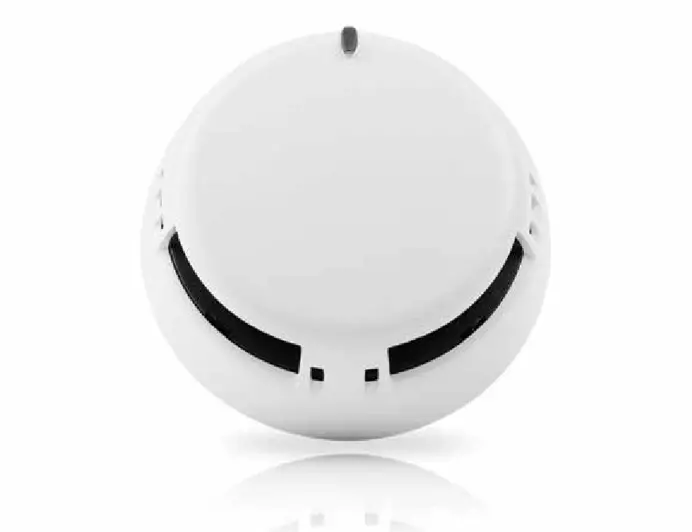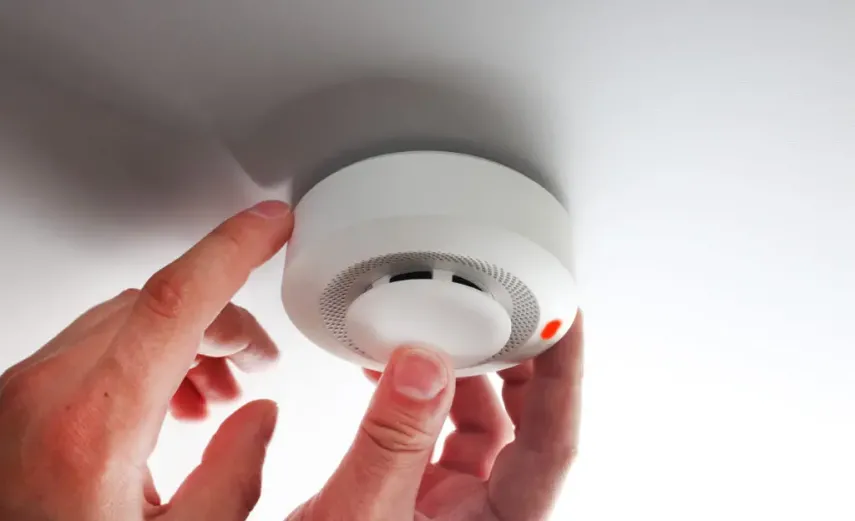With the rapid advancement of technology in today’s world, various devices are being developed to make our lives safer and more comfortable. One of these devices is fire and smoke detectors. These two devices play a significant role in fire prevention and serve as a life-saving early warning system.
A fire detector is a security device designed to detect a potential fire and trigger an alarm. Its primary function is to detect fire indicators in the environment, such as increased temperature, flames, or smoke. Fire detectors can be categorized into two main types: ionization type and optical (photoelectric) type. These types of fire detectors are always popular due to their advanced technology.
A smoke detector is a security device used to detect smoke in the environment and indicate a fire hazard. There are two main types of smoke detectors: ionization type and optical type. Each type of detector has its own unique features, so it’s important to choose a product that perfectly meets your specific needs when making a device selection.
Fire detectors and smoke detectors are essential components of modern security measures. Regular maintenance and keeping these devices operational are of great importance for both property protection and ensuring our safety. Fire and smoke detectors serve as a powerful example of how technology can enhance our safety and security.
Fire Detector Prices
Fire detectors come in a wide price range with different types and features. So, what affects fire detector prices and on which factors do they vary? Fire detector prices are determined by the interplay of various factors. Here are the criteria to consider when discussing fire detector prices:
Type and Technology
There are different types such as ionization-type or optical-type fire detectors. Optical-type detectors are generally more common and cost-effective. However, ionization-type detectors can provide more sensitive fire detection, which may lead to a higher price.
Additional Features
Some fire detectors may have additional features like carbon monoxide or gas detection, which can increase the price.
Brand and Quality
Prices from professional brands are often higher. However, lower-cost brands can also offer quality products.
Alarm System
Fire detectors are typically used as standalone devices. However, they can also be integrated into a home or business security system, and this integration can also affect the price.
Types of Fire Detectors
Fire detectors are typically designed to detect fire indicators such as heat and smoke. There are two main types. Ionization-type detectors detect fire smoke by using the electrical conductivity of ions in the air. Optical-type detectors, on the other hand, detect how smoke particles obstruct beams of light.
Fire is a danger that can suddenly emerge and cause significant damage. Therefore, fire detectors are of vital importance as early warning and detection systems. Fire detectors come in various types with different operating principles and features.
Battery-Powered Smoke Detector
Enhancing security has led to the adoption of various technological solutions in homes and workplaces today. One of these technological solutions is ‘battery-powered smoke detectors.’ These devices provide early warning against fire hazards, significantly increasing safety and minimizing financial losses.
Battery-powered smoke detectors primarily operate on the principle of smoke detection and alert through the sensors and alarm mechanism they contain. The working principle is quite simple: if the smoke density in the environment increases, the detector detects it and triggers the alarm.
The ‘optical sensors’ inside smoke detectors measure how smoke particles in the environment scatter or block light. If the smoke density increases, the light path in the sensors is obstructed or the amount of scattering changes. This change leads to the detector triggering an alarm.
Optical Smoke Detector
Optical fire detectors are a widely used type designed for smoke detection. Their operation principle is based on the scattering or blocking effect created by smoke in the environment. They contain a light source and a photodiode sensor. When smoke particles reach the sensor on the path of light, the sensor’s signal changes, triggering the detector’s alarm. Optical fire detectors detect smoke in the early stages of a fire while minimizing false alarms.

Beam Type Smoke Detector
Thermal fire detectors operate by detecting increased temperature levels in the environment. They contain thermal sensors or thermistors that are sensitive to temperature changes. When a predetermined temperature threshold is reached, the detector triggers an alarm. Thermal detectors can detect fire indicators without the presence of flames or smoke, making them especially useful for detecting flameless fires.
Ionization Smoke Detector
Ionization fire detectors operate by measuring the levels of ionization in the air. The air between the two electrodes inside the detector becomes ionized, and normally, the electrical current is interrupted. However, if smoke particles enter the detector, the ionization effect decreases, and the circuit is completed. This situation leads to the detector triggering a fire alarm. Ionization detectors are generally known for their fast response times but may be more prone to false alarms.
Features of a Smoke Detector
The primary function of smoke detectors is smoke detection. Therefore, the optical sensors they contain trigger the alarm by detecting the presence of smoke in the environment. These sensors measure the effect of smoke particles on the path of light and sound the alarm. When smoke detectors detect smoke density, they generate a loud and audible alarm sound. This sound enables early detection of danger and facilitates swift intervention.
Many smoke detectors are battery-operated, which ensures the device’s continued operation even during power outages. Long-lasting batteries provide uninterrupted protection. Smoke detectors often come with test buttons, which are used to check if the device is functioning properly. Additionally, a ‘silence’ mode is a useful feature for preventing false alarms.
Some smoke detectors can be integrated with home security systems or smart home systems. This allows for notifications to be sent to homeowners in the event of a fire. Smoke detectors can also store previous alarm events in their memory, providing detailed information when events are reviewed. When choosing a detector, it is important to select a product that fully meets your expectations.
Smoke detectors typically consist of a room with a light source and a sensor inside. The sensor detects how smoke particles in the air obstruct the light. This detection triggers the detector’s alarm, sending a warning signal in case of danger.
How Does a Smoke Detector Work?
The most commonly used operating principle for smoke detectors is optical sensor technology. These sensors contain a light source and a photodiode sensor inside the device. The light source is positioned opposite a sensor inside the detector, and the light from the light source reaches the sensor directly.
During a fire, the smoke particles generated obstruct or scatter the path of light. This alteration changes how the light falls on the sensor. The change in the amount of light reaching the sensor is detected by the detector’s processor. If the smoke density increases, a drop in light on the sensor is detected, triggering the detector’s alarm.
Smoke detectors aim to detect smoke in the environment and identify fire hazards at an early stage. One of the biggest dangers during fires is the spread of toxic gases and smoke. Therefore, smoke detectors stand out with their ability to detect imperceptible dangers at an early stage.
Does the Smoke Detector Blow on Cigarettes?
Yes, smoke detectors can react and alarm to smoking or other smoke sources. Smoke detectors generally work by detecting smoke particles in the environment. These smoke particles can originate from various sources such as fire, cooking in the kitchen or cigarette smoke.
Smoke detectors, especially those using optical sensor technology, work by smoke particles blocking the path of light or creating a scattering effect. Therefore, when smoke particles from cigarette smoke or similar sources reach the detector’s sensors, the detector recognises this as a smoky environment and triggers an alarm.
This feature of smoke detectors is designed to increase safety and quickly detect dangerous situations. Therefore, reacting to smoke sources such as cigarette smoke increases the functionality and effectiveness of the detector. Therefore, paying attention to the usage features of such devices; allows you to get the desired effect from these devices.
How Many Metres Should a Smoke Detector Be?
In general, it is recommended to have at least one smoke detector on each floor in a home or business. In addition, main access points such as bedrooms and corridors should also be considered. Many guidance documents recommend placing detectors at intervals of 9 to 12 metres in corridors and around sleeping areas. This can increase the ability of the detectors to detect smoke in the early stages of a dangerous situation.
How to tell if the smoke detector is working?
It is important to test and understand whether the smoke detector is working properly. Smoke detectors usually have a “Test” button on them, which allows you to check the working status of the detector. There are many different ways to find out if the smoke detector is working. Here, it is an indispensable rule that you first master the basic features of your own device!
There is usually a button such as “Test” or “Test/Reset” on the smoke detector. You can check the working status of the detector by pressing this button. When you press the button, the detector does not make its own alarm, but a siren sound as if it normally alarms. This indicates that the detector’s sensors and alarm system are working properly.
Many smoke detectors have an LED light that indicates the operating status. This light indicates that the detector is powered and ready. If this light flashes normally, the detector is working. Regularly testing the smoke detector is a good way to check that it is working. It is usually a good habit to test the detector once a month or every six months. This can be done by pressing the button or without creating a smoke source.
Of course, in the event of a real danger, the smoke detector alarm will definitely sound. If the detector’s alarm works without a fire or smoke source, this may indicate a problem and you may need to check your detector. If you think the smoke detector is not working properly, or if it does not alarm when you test it, it is important to check your detector and replace it if necessary. Regular testing is recommended to ensure your safety.
Fire and smoke detectors are extremely important to prevent not only material damages but also loss of life. When properly positioned, these devices provide early warning, helping people to quickly retreat to safe areas. They can also help reduce fire insurances in homes or commercial buildings. Therefore, when it comes to fire and smoke detectors in today’s conditions, we come across an extremely useful technology!
What Types of Fires Can Smoke Detectors Detect?
Smoke detectors are generally used to detect smoke in the early stages of fires. When these detectors detect smoke, they report the fire hazard.
What are the Advantages of Smoke Detectors?
The advantages of smoke detectors can be the following: Early fire detection, low false alarm rate, cost-effective and easy operation.
